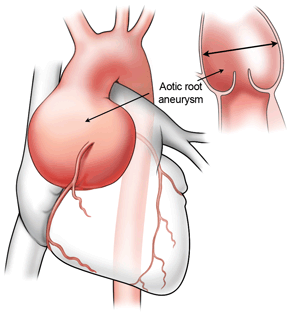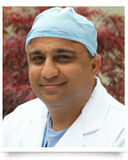“Will An Enlarged Aorta Return to Normal Size After Bicuspid Aortic Valve Replacement?” Asks Mary
By Adam Pick on August 4, 2014
I just received several excellent questions from Mary about bicuspid aortic valve replacement, aorta size and heart valve replacement devices. In her email, Mary writes, “Hi Adam – I want to know whether an enlarged aorta returns to normal after bicuspid valve replacement. Also do you have an opinion as to which is better, bovine or mechanical valve. Thank you.”

To help Mary, I contacted Dr. John Kern, who is the Chief of Cardiothoracic Surgery at the University of Virginia Health System. So you know, Dr. Kern has successfully treated several members from our community including Todd Breeden.
In his response, Dr. Kern first answered Mary’s question about the size of the aorta following a bicuspid aortic valve replacement operation:
Hello Mary, your question concerning an enlarged aorta associated with a bicuspid aortic valve is a very good one. While the association between a bicuspid aortic valve and an enlarged ascending aorta (or an ascending aortic aneurysm) is well known, we still aren’t completely sure of the exact cause. The answer to your question is that an enlarged aorta will not return to normal size after replacing the bicuspid valve alone. For this reason, it is important to know exactly how big the aorta is prior to undergoing valve replacement. If someone has a bicuspid aortic valve in need of replacement, and the ascending aorta is 5 centimeters or more in diameter, then the aorta should be replaced as well. In some individuals, the aorta may need to be replaced even if it is only 4.5 centimeters in diameter. It is also important to note that not everyone with a bicuspid valve needs to have it replaced. Only if the valve is leaking severely or has become heavily calcified and stenotic should a bicuspid valve be replaced, and many bicuspid valves function completely normally forever and never need replacement. If the aorta is not replaced at the time of the valve replacement, then it still may need to be monitored over time with periodic CT or MR scans to make sure it doesn’t continue to enlarge.
Then, Dr. Kern addressed Mary’s questions about the different types of heart valve replacement devices:
The question of a bovine or mechanical valve is also a very good one, and the answer can be quite complex. All replacement heart valves have pros and cons. In general we classify replacement valves into two categories, biologic (or tissue) valves and mechanical valves. The biologic or tissue valves are usually bovine pericardial or bovine. The benefit of the tissue valves is that you will not need to be on blood thinners forever. However, tissue valves may not last forever and can deteriorate and become calcified over time and then you would need another valve. Fortunately, the durability of presently available tissue valves is excellent and when used to replace the aortic valve, they can often last for 15-20 years or even longer. In addition, when a tissue valve wears out it may be possible to re-replace it without the need for repeat open heart surgery by using the newly developed trans-catheter heart valve. The mechanical valve on the other hand is generally free from structural failure, meaning that it won’t wear out, however, this should not be taken to mean that if you choose a mechanical heart valve you will never need another heart operation. In the human body, sometimes scar tissue can grow into the mechanical valve over the course of years which could prevent the valve from working normally and then you would need another valve. Also, with a mechanical valve you will need to be on blood thinners forever. While being on a blood thinner can be very safe, you may need to alter your life-style or diet as a result and you may become prone to bleeding problems. So as you can see, there is no “right” answer when it comes to choosing a replacement heart valve and it really depends on you understanding the pros and cons of each valve and making the decision that you feel is best for you. Your cardiologist and surgeon can best assess your situation, and then based on your age and other medical problems can help you choose which valve is best for you.
I hope this helped Mary (and perhaps you) learn more about enlarged aortas, bicuspid aortic valve surgery and heart valve replacement devices. Many thanks to Mary for her question and a special thanks to Dr. John Kern for sharing his clinical experiences and research with our patient community!
Keep on tickin!
Adam
|
Karen Dust says on August 5th, 2014 at 5:14 pm |
|
Hi, In regards to Dr. Kern’s response to the ascending aortic aneurysm question; he stated that some people may need it replaced at 4.5 centimeters….how does one go about determining if it needs to be replaced between 4.5 & 5.0 centimeters? Mine was 4.9 in July 2014, 4.8 March 2014, 5.0 Dec 2013 and 4.7 Nov 2012. My surgeon has stated that they will not remove it until it hits 5.0 or greater again. Thoughts? Thank you, Karen Dust |
 |
|
Sonia Castro says on August 5th, 2014 at 5:45 pm |
|
There’s another valve better than an mechanical valve |
 |
|
Sonia Castro says on August 5th, 2014 at 5:55 pm |
|
I have loeys dietz syndrome with a mechanical valve on Coumadin for 14 yrs I need another surgery my button fell off on my coronary artery there’s a better valve |
 |
|
Terry says on August 5th, 2014 at 8:06 pm |
|
I was diagnosed on July 24 with an aortic aneurysm and valve regurgitation. I had selected the Ross procedure, but now I’m not so sure. Is there a benefit for an active (runner, cyclist, hiker) 54- year-old for the Ross over bovine valve replacement? |
 |
|
John Dobry says on August 5th, 2014 at 9:34 pm |
|
In my case I had severe stenosis and a 48mm aortic arch. One surgeon said he would just put in a porcine valve and not do the aortic arch. On my second opinion the chief of cardio thoracic surgery at Royal Oak Beaumont in Michigan told me when I asked him what could happen if I did not have the aortic arch replaced he said simply another surgery. Also, I chose mechanical and blood thinners rather than tissue when faced with possibly having open heart surgery to replace valves every 10 years. Morbidity increases with each surgery. As it turned out my valve was severely calcified and I am glad I chose my treatment option. But everyone needs to choose what best fits their lifestyle. Interestingly enough I had a college that had an enlarged aortic arch replaced and his bicuspid aortic valve was not replaced as there wasn’t any calcification |
 |
|
Tom Bender says on August 5th, 2014 at 10:15 pm |
|
I was telling one of my coworkers about me having my aorta valve and aorta replaced with an Edwards bovine tissue valve and Dacron aorta. He asked me if I knew why or how the body does not reject the tissue valve and the Dacron. And why Wedon’t have to take anti-rejection meds. Can someone provide insight? BTW: I am doing fine at the 8 month mark. |
 |
|
Charles A Womack says on August 6th, 2014 at 1:07 am |
|
I had my bicuspid aortic valve (calcified) replaced with bovine tissue along with a synthetic graft for a 5.1 cm aortic aneurysm on Jan. 14, 2013. So far, everything seems to be ok. |
 |
|
Vince Kelley says on August 6th, 2014 at 10:09 am |
|
I’m responding to Terry’s question on Ross over bovine replacement of the aortic valve. I had the Ross procedure with bovine replacement of my pulmonary valve, which had been moved to replace my leaking aortic valve. The advantage of having the bovine valve in this location (as explained by both my cardiologist and surgeon) is that it will be under lower pressure and should (could) last longer than if it was in the aortic valve location. Being active like Terry, (I am also a runner, biker, and hiker) I am very happy with my choice as I do not have to worry about blood thinners. I was 53 at the time of my surgery in December of 2009. Since then I have run 2 marathons, 10 half marathons, and well over 6000 miles. My last cardiac checkup in May, 2014 showed no changes since my surgery. For an active person, I would recommend the Ross Procedure. |
 |
|
Terry says on August 7th, 2014 at 2:24 pm |
|
So things just got MUCH more interesting. The surgeon in Iowa City just called and after a review of my scans told me that things were worse than I thought. My mitral valve is failing and the original diagnosis didn’t address this. He said the Ross Procedure is out, and that his ‘Plan A’ would be a mitral valve neochord (goretex) replacement, with a valve-saving dacron replacement of the aortic root. If the mitral valve replacement didn’t work during surgery, the ‘Plan B’ would be a replacement of both mitral and aortic valves with mechanical valves. Yikes. Anyone have experience with this particular procedure? |
 |
|
Alexander says on August 9th, 2014 at 6:32 am |
|
I am almost 3 weeks post operative and doing well, just the waiting game of healing and mending. |
 |
|
steven a husted says on August 9th, 2014 at 10:37 am |
|
i agree with you alexander i was thinking mechanical to start then i changed my mind because in 10 – 15 years i could have the transcatheter valve replacement and no coumadin for that 10 -15 years or blood tests or clicking |
 |
|
Alexander says on August 10th, 2014 at 3:22 pm |
|
Hi Steven, I think you have made a wise choice. May I ask, when to you anticipate your procedure to be carried out ? |
 |
|
Ella Jackson says on August 15th, 2014 at 6:15 pm |
|
Thank you, Adam Pick, I am newly diagnosed with AR and this blog and its contents were very helpful to me. Ella Jackson |
 |
|
Randy says on August 16th, 2014 at 7:16 am |
|
Interesting to read the pros and cons of mechanical verses tissue valves.I have a mechanical mitral valve replaced one year ago this past may. I chose mechanical over tissue because of being only 61 didn’t like the thought of another possible surgery in 10 years or so. Also I’m not an active sports person or mountain climber. The blood thinner is the only draw back. Going to the clinic once a month to have it checked. I don’t know I think if I had to do it again I would still go with the mechanical. The longevity is what I was after it will probably outlast the rest of me. |
 |
|
Terry says on September 5th, 2014 at 11:32 pm |
|
I ended up having the Bentall procedure; the mitral valve didn’t need to be replaced. It was being pushed out of shape by the aortic valve’s regurgitation. Dr. Harold Roberts in Aventura (Miami) did the operation. He’s the best! Yesterday was the 3rd week after the surgery; I’m recovering and doing physical therapy and walking 20 minutes a day and am on my way back to my active lifestyle (Dr. Roberts used a bovine pericardial valve to replace my damaged aortic valve, sparing me blood thinners). Mountains, here I come… Thanks, Adam Pick, for the book and this blog. Don’t know what I would have done without the information contained here. |
 |
|
Terry says on September 19th, 2014 at 9:20 pm |
|
I had an echocardiogram last week, and my ejection fraction is 35%. It was 45% before the surgery. My cardiologist said that my heart had been over-working for years with the regurgitation caused by the un-diagnosed aortic aneurysm, and the heart’s adaptation to the regurgitation (slightly enlarging) coupled with the ‘stunning’ of the heart by the surgery probably caused the drop in EF. He’s put me on Diovan in addition to Metroprolol and says that the heart can return to an EF in the normal range (55-70%). As Adam says, everyone’s recovery is different… hoping my next echo in December will show some improvement. Starting cardiac rehab next week, which he says will also help. Good news: the new valve is working perfectly! |
 |














